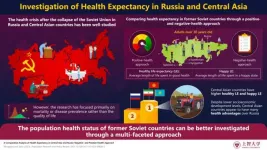(Press-News.org) FOR IMMEDIATE RELEASE
A Johns Hopkins Children’s Center study of children and youth with diabetes concludes that so-called autonomous artificial intelligence (AI) diabetic eye exams significantly increase completion rates of screenings designed to prevent potentially blinding diabetes eye diseases (DED). During the exam, pictures are taken of the backs of the eyes without the need to dilate them, and AI is used to provide an immediate result.
The study noted that the AI-driven technology used in the exams may close “care gaps” among racial and ethnic minority youth with diabetes, populations with historically higher rates of DED and less access to or adherence with regular screening for eye damage.
In a report on the study published Jan. 11 in Nature Communications, investigators examined diabetic eye exam completion rates in people under age 21 with type 1 and type 2 diabetes, and found that 100% of patients who underwent AI exams completed the eye assessment.
DED primarily refers to diabetic retinopathy, a potentially blinding complication of diabetes that occurs when poorly controlled sugar levels cause the overgrowth of, or damage to, blood vessels and nerve tissues in the light-sensitive retina at the back of the eye. According to the study researchers, retinopathy affects between 4% and 9% of youth with type 1 diabetes, and 4% to 15% of youth with type 2 diabetes. About 238,000 children, adolescents and young adults under age 20 are estimated to have diagnosed diabetes, according to the American Diabetes Association. Frequent screenings for DED facilitate early detection and treatment, and can help prevent progression of DED.
Generally, diabetes specialists and eye doctors recommend annual screenings, which typically require an additional, separate visit to an eye care provider, such as an optometrist or ophthalmologist, and the use of drops to dilate the pupil so that a clear view of the retina is visible through specialized instruments. However, studies show only 35% to 72% of youth with diabetes undergo recommended screenings, with even higher care gap rates among minority and poor youth. Previous studies also show that barriers to screenings include confusion about the need for screenings, inconvenience, and lack of time, access to specialists and transportation.
Previous studies by Risa Wolf, M.D., a pediatric endocrinologist at Johns Hopkins Children’s Center, and her team have found autonomous AI screening that uses cameras produce results that enable accurate DED diagnosis.
In the new study, researchers enrolled 164 participants, ranging in age from 8 to 21 years and all from the Johns Hopkins Pediatric Diabetes Center, between Nov. 24, 2021, and June 6, 2022. Some 58% were female and 41% were from minority groups (35% Black; 6% Hispanic). Some 47% of participants had Medicaid insurance. The subjects were randomly assigned to one of two groups. A group of 83 patients received the standard screening instructions and care, and were referred to either an optometrist or ophthalmologist for an eye exam. A second group of 81 patients underwent a five-to-10-minute autonomous AI system diabetic eye exam during a visit to their endocrinologist (the specialists who typically care for people with diabetes), and received their results at the same visit.
The AI system takes four pictures of the eye without dilation, and runs the images through an algorithm that determines the presence or absence of diabetic retinopathy, Wolf says. If it is present, a referral is made to an eye doctor for further evaluation. If it is absent, “you’re good for the year, and you just saved yourself time,” she adds.
Researchers found that 100% of patients in the group offered the autonomous AI screening completed their eye exam that day, while 22% of patients from the second group followed through within six months to complete an eye exam with an optometrist or ophthalmologist. The researchers found no statistical differences based on race, gender or socioeconomic status for whether participants in the second group scheduled the separate screening with an eye doctor.
The researchers also found that 25 out of 81 participants, or 31%, in the autonomous AI group had a result indicating that DED was present. Sixteen of those participants, or 64%, followed through in scheduling a secondary appointment with an eye care provider. Further analysis showed those who did not schedule the appointment were more likely to be Black and have Medicaid insurance.
“With AI technology, more people can get screened, which could then help identify more people who need follow-up evaluation,” says Wolf. “If we can offer this more conveniently at the point of care with their diabetes doctor, then we can also potentially improve health equity, and prevent the progression of diabetic eye disease.”
The investigators caution that the autonomous AI used in their study is not approved by the U.S. Food and Drug Administration for those under 21 years old. And they say a potential source of bias in the study was that some of the participants were familiar with autonomous AI diabetic eye exams from a prior study, and therefore may have been more willing to participate in the new one.
Along with Wolf, the study authors from Johns Hopkins include Alvin Liu, Anum Zehra, Lee Bromberger, Dhruva Patel, Ajaykarthik Ananthakrishnan, Elizabeth Brown, Laura Prichett and Harold Lehmann. Other authors are Roomasa Channa from University of Wisconsin and Michael D. Abramoff from the University of Iowa.
The study was funded by the National Eye Institute of the National Institutes of Health (Award Number R01EY033233) and the Diabetes Research Connection.
The authors associated with The Johns Hopkins University declared no conflicts of interest related to this press release.
END
Study finds AI-driven eye exams increase screening rates for youth with diabetes
Johns Hopkins Children’s Center investigators say AI-driven cameras that take images of the back of the eye and require no eye drops can be used to close care gaps
2024-01-11
ELSE PRESS RELEASES FROM THIS DATE:
U.S. health costs related to chemicals in plastics reached $250 billion in 2018
2024-01-11
WASHINGTON—Endocrine-disrupting chemicals (EDCs) in plastics pose a serious threat to public health and cost the U.S. an estimated $250 billion in increased health care costs in 2018, according to new research published in the Journal of the Endocrine Society.
Plastics contain many hazardous, endocrine-disrupting chemicals that leach and contaminate humans and the environment. These chemicals disturb the body’s hormone systems and can cause cancer, diabetes, reproductive disorders, neurological impairments of developing fetuses and children, and death.
Potential options under discussion as part of a Global ...
Experiments in infant mice suggest new way to prevent spread of flu in people
2024-01-11
Scientists have long known that some viruses and bacteria begin infections by latching first onto sugar molecules on the surfaces of cells lining the sinuses and throat of mammals, including humans. Viral particles, for instance, can attach to these molecules, called sialic acids, or SAs, like keys fitting into locks.
Now, a new study in infant mice shows that keeping virus particles from attaching to SAs limits more than just the entry of influenza A viral infections, but also hinders their exit (shedding) and transmission from mouse to mouse. Such infections are the main cause of the seasonal flu that kills more than 36,000 Americans annually. While vaccines to guard ...
A universal coronavirus vaccine could save billions of dollars if ready before next pandemic
2024-01-11
What if scientists had developed a universal coronavirus vaccine in the years prior to 2020 so that it was available at the start of the COVID-19 pandemic? A universal coronavirus vaccine targets parts of the virus that are common to either many or all coronaviruses, thereby offering some degree of protection against a range of strains. A new study suggests if such a vaccine were available at the start of the pandemic, it could have saved millions of lives, prevented suffering, and saved billions of dollars in direct medical ...
Virtual Science Writers Conference will uncover the truth behind ‘hormone balancing’
2024-01-11
WASHINGTON—The popular TikTok trend of ‘hormone balancing’ has taken over the internet with claims to balance your hormones with holistic approaches alone, but medical experts question its legitimacy.
Endocrine Society expert Deena Adimoolam, M.D., will discuss ‘hormone balancing’ during the Society’s Virtual Science Writers Conference on January 24.
What: The Virtual Science Writers Conference will examine:
How hormones function and stay in balance
Common ...
Toxic algae blooms: Study assesses potential health hazards to humans
2024-01-11
Florida’s 156-mile-long Indian River Lagoon (IRL) borders five different counties and has five inlets that connect the lagoon with the Atlantic Ocean. In recent years, this estuary has experienced numerous phytoplankton bloom events due to increased seasonal temperatures coupled with environmental impacts.
Algal blooms produce a myriad of small organic molecules, many of which can be toxic to humans and animals. Among these phycotoxin producers is Microcystis aeruginosa, a freshwater cyanobacterium, which can be found in the Southern IRL. Measurable amounts of microcystins have been found in nasal swabs ...
Researchers discover potential microbiome links to skin aging
2024-01-11
The effects of aging and external factors like UV exposure on skin are well documented. As people age or spend more time in the sun, their skin tends to become drier and more wrinkled,
Recent findings have identified an exciting potential new link to signs of skin aging—the skin microbiome, the collection of microorganisms that inhabits our skin. The results come from a collaborative study carried out by researchers at the Center for Microbiome Innovation (CMI) at the University of California San Diego (UC San Diego) and L'Oréal ...
Join us in sunny San Diego for the ATS 2024 International Conference May 19-22
2024-01-11
What’s New: Register now to learn about the latest in pulmonary, critical care and sleep medicine. Join us for scientific sessions and expert interviews. Thirteen sessions will be livestreamed.
Why it matters: Stay up-to-date on subjects like COVID-19, asthma, COPD, and air pollution. We’ll assist you with conducting interviews, whether in-person or from your home office.
Contact Kevin Tuerff, ATS Communications & Marketing for more information, at ktuerff@thoracic.org END ...
Chemical Insights Research Institute commits to public health research with the opening of new laboratories
2024-01-11
ATLANTA – Chemical Insights Research Institute (CIRI) of UL Research Institutes confirmed its commitment to protecting environmental and human health when it opened its new research laboratories supporting scientific studies of environmental exposure and its societal health impact. At a ribbon cutting today, CIRI introduced the Center for Exposure Science; the Center for Toxicology and Human Health; and the Center for Advanced Measurements, each with a designated, cutting-edge laboratory.
Using the latest tools for measuring nanosized particles and parts per billion levels of chemicals and developing high-throughput cellular techniques for measuring human toxicity, ...
Challenging the traditional views on how the brain processes movement and sensation
2024-01-11
The brain is widely considered the most complex organ in the human body. The intricate mechanisms through which it processes sensory information and how this information affects and is affected by motor control have captivated neuroscientists for more than a century. Today, thanks to advanced laboratory tools and techniques, researchers can use animal models to solve this puzzle, especially in the mouse brain.
During the 20th century, experiments with anesthetized mice proved that sensory inputs primarily define neuronal activity in the primary ...
Understanding healthy and happy expectancy in former soviet countries
2024-01-11
The dissolution of the Soviet Union in 1991 marked the start of a period ripe with political, economic, and societal changes. In many former Soviet countries, these abrupt and turbulent transformations posed massive challenges to healthcare systems. Together with spikes in job losses and economic hardships, this led to a steep increase in mortality rates that would later come to be known as the “post-Soviet mortality crisis.”
However, this crisis did not affect all former Soviet countries equally. In particular, former Soviet countries in Central Asia, which include Kazakhstan, Kyrgyzstan, Tajikistan, Turkmenistan, and Uzbekistan, saw a ...
LAST 30 PRESS RELEASES:
When is it time to jump? The boiling frog problem of AI use in physics education
Twitter data reveals partisan divide in understanding why pollen season's getting worse
AI is quick but risky for updating old software
Revolutionizing biosecurity: new multi-omics framework to transform invasive species management
From ancient herb to modern medicine: new review unveils the multi-targeted healing potential of Borago officinalis
Building a global scientific community: Biological Diversity Journal announces dual recruitment of Editorial Board and Youth Editorial Board members
Microbes that break down antibiotics help protect ecosystems under drug pollution
Smart biochar that remembers pollutants offers a new way to clean water and recycle biomass
Rice genes matter more than domestication in shaping plant microbiomes
Ticking time bomb: Some farmers report as many as 70 tick encounters over a 6-month period
Turning garden and crop waste into plastics
Scientists discover ‘platypus galaxies’ in the early universe
Seeing thyroid cancer in a new light: when AI meets label-free imaging in the operating room
Neutrophil-to-lymphocyte ratio may aid risk stratification in depressive disorder
2026 Seismological Society of America Annual Meeting
AI-powered ECG analysis offers promising path for early detection of chronic obstructive pulmonary disease, says Mount Sinai researchers
GIMM uncovers flaws in lab-grown heart cells and paves the way for improved treatments
Cracking the evolutionary code of sleep
Medications could help the aging brain cope with surgery, memory impairment
Back pain linked to worse sleep years later in men over 65, according to study
CDC urges ‘shared decision-making’ on some childhood vaccines; many unclear about what that means
New research finds that an ‘equal treatment’ approach to economic opportunity advertising can backfire
Researchers create shape-shifting, self-navigating microparticles
Science army mobilizes to map US soil microbiome
Researchers develop new tools to turn grain crops into biosensors
Do supervised consumption sites bring increased crime? Study suggests that’s a myth
New mass spec innovation could transform research
Maternal nativity, race, and ethnicity and infant mortality in the US
Migration-related trauma among asylum seekers exposed to the migrant protection protocols
Jupiter’s moon Europa has a seafloor that may be quiet and lifeless
[Press-News.org] Study finds AI-driven eye exams increase screening rates for youth with diabetesJohns Hopkins Children’s Center investigators say AI-driven cameras that take images of the back of the eye and require no eye drops can be used to close care gaps



